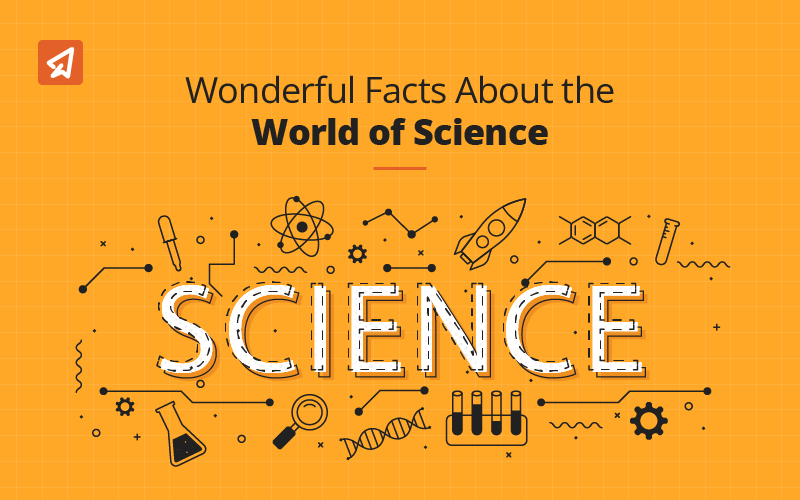Interesting Science Facts from the World of Science

Science is more than just a subject studied in classrooms or laboratories. Science is a part of every facet of our daily lives. It is a part of the air we breathe, the water we drink, and the earth we live on. We rely on science to create the technologies we use every day.
In fact, it pushes the boundaries of what we know and uncovers the universe’s mysteries. Let us explore some of the most astounding things about science and what makes our world special! Prepare to have your mind blown.

1. You Can’t Taste Food Without Smelling It
Have you ever wondered why food is tasteless when you have a cold? It’s actually because our ability to taste relies significantly on our sense of smell. In fact, about 80% of the flavours we taste come from what we smell. Our olfactory receptors work with our taste buds to create the perception of flavour. This explains why holding your nose while eating can reduce the intensity of flavour.
2. Honey Never Spoils
Did you know that honey can remain edible for millennia? This ability is truly remarkable. We have found honey in ancient Egyptian tombs, over 3,000 years old, that is still safe to eat. Honey’s longevity is because it is high in sugar, and has low moisture content and low pH. These create an environment that is inhospitable for bacteria and microorganisms. Additionally, its high acidity prevents the growth of most pathogens.
3. A Day Can be Longer Than a Year
Yes, it’s true. Days can be longer than years! Especially if you’re on Venus! Venus’s slow rotation is a baffling phenomenon. After all, it takes longer for Venus to complete one rotation on its axis than it does for it to orbit the sun. This means that a day on Venus (one complete rotation) lasts longer than its year (one orbit around the sun). This slow rotation contributes to Venus’ extreme temperature, which makes it the hottest planet in the solar system.
4. Plants Communicate Through Underground Networks
Research has recently discovered that plants can communicate with each other! They do this through intricate underground networks often referred to as the “Wood Wide Web”. They are made of symbiotic relationships between fungi and the roots of plants. Through these connections, plants can warn each other about pests, share nutrients, and even sabotage unwelcome plants.
5. Bumblebees Can Fly Higher Than Mount Everest
Bumblebees have tiny wings relative to their body size. Yet, they defy aerodynamics and are capable of flying even higher than Mount Everest! Scientists have found that bumblebees can reach great altitudes, showcasing incredible adaptations. This is only one of the several extraordinary capabilities of these tiny wonders.
6. Glass is Made Entirely from Sand
Did you know? One of the most commonplace materials in our daily lives, glass, begins its journey as mere sand. Silica is a natural compound found in sand. Firstly, it is heated to high temperatures, transforming it into a liquid state. Upon cooling, it hardens into glass. This remarkable process allows for the creation of everything from simple windows to intricate glass sculptures.
7. The Sun’s Mass Takes Up 99.86% of the Solar System
The sun is a colossal powerhouse at the heart of our solar system. We all know how enormous the sun is, but did you know that it holds 99.86% of the system’s total mass? This staggering figure highlights the immense scale of the sun. It is a constant reminder of our place in the universe – a tiny speck orbiting a giant ball of energy.
8. A Single Lightning Bolt Can Have Enough Electricity to Power 100 Homes
Lightning is one of nature’s most dramatic displays of power. It can unleash an astonishing amount of energy in a single strike. In fact, a single lightning bolt can generate enough electricity to power 100 homes. While this is hard to do in practice since it is a challenge to collect the energy from the lightning strike, it goes to show the immense power of the environment.
9. Some Frogs Can Freeze Without Dying
In the cold parts of the world, some frog species exhibit a magical ability to survive freezing temperatures. Wood frogs, for example, can freeze solid during the winter. Even if their heart and brain activity stops, they don’t die. Come spring, they thaw out and resume their bodily functions. This adaptation causes the rapid release of glucose in their body. This acts as a natural antifreeze, preventing damage to their cells. This behaviour opens up fascinating avenues for medical research, particularly in cryogenics.
10. Individual Blood Cells Take About 60 Seconds to Go Around the Whole Body
Our bodies are marvels of natural engineering. The circulatory system is a prime example of incredible design. Did you know that it only takes an individual blood cell about 60 seconds to complete a circuit around the body? This rapid journey is essential for life as blood cells transport oxygen and nutrients to tissues while removing waste products. The efficiency of this system highlights the incredible capability of the human body to maintain itself.
The world of science is vast and filled with wonders that exceed even our wildest imaginations. It allows us to explore, understand, and appreciate the complexities of life.
11. Bananas are Radioactive
Bananas contain potassium, and a small portion of that potassium is a radioactive isotope called potassium-40. This isotope decays over time, emitting radiation. However, the level of radiation is minuscule and poses no health risk. In fact, your body already contains potassium-40, and eating a banana only temporarily increases this amount by about 0.4%. The concept of the “banana equivalent dose” is often used to explain radiation exposure in everyday terms—eating one banana exposes you to about 0.1 micro sieverts of radiation, which is harmless.
12. Water Can Boil and Freeze at the Same Time
This phenomenon occurs at the triple point of water, where the temperature and pressure are just right for water to exist simultaneously as a solid, liquid, and gas. The triple point for water is at 0.01°C (32.018°F) and a pressure of 611.657 pascals (about 0.006 atmospheres). At this point, water can boil (turn into vapor) and freeze (turn into ice) at the same time
13. It Can Rain Diamonds on Neptune and Uranus
On planets like Neptune and Uranus, extreme pressures deep within their atmospheres can compress carbon into solid diamonds. This “diamond rain” forms as methane in the atmosphere breaks down under high pressure, releasing carbon atoms that crystallize into diamonds as they fall deeper into the planet’s interior. These diamonds could be much larger than those found on Earth.
14. There Are More Trees on Earth Than Stars in the Milky Way
NASA estimates that there are between 100 billion and 400 billion stars in our galaxy, the Milky Way. However, Earth is home to over 3 trillion trees—far more than the number of stars in our galaxy. This vast number of trees plays a crucial role in absorbing carbon dioxide from the atmosphere and producing oxygen.
15. The Oceans Produce Most of Earth’s Oxygen
While trees are often credited with producing oxygen, marine organisms like phytoplankton are responsible for generating about 50% to 85% of Earth’s oxygen through photosynthesis. These microscopic plants convert carbon dioxide into oxygen in the vast surface area of the oceans.
16. Cows Kill More People Than Sharks
Despite their docile appearance, cows are responsible for more human fatalities each year than sharks. Cows can become aggressive when they feel threatened or when protecting their young, leading to accidental deaths through trampling or charging. In contrast, shark attacks are rare, with only a few fatalities worldwide each year.
17. Some Fungi Turn Ants Into “Zombies”
The Ophiocordyceps fungus infects ants by taking over their nervous systems and manipulating their behavior. Infected ants leave their colonies and climb vegetation before biting down on leaves or twigs—a behavior known as the “death grip.” The fungus then kills the ant and grows a stalk from its body to release spores and infect other ants.
18. Sloths Only Defecate Once a Week
Sloths have an incredibly slow metabolism, which means they digest food very slowly. As a result, they only descend from trees about once a week to defecate on the ground—a process that can take up to half an hour. This behavior is thought to help fertilize trees or avoid predators while they remain motionless most of the time.
19. It Takes About 60 Seconds for Blood Cells to Circulate Through Your Body
Your circulatory system is incredibly efficient: it takes about one minute for a red blood cell to travel from your heart, through your body’s network of blood vessels, and back again10. This rapid circulation ensures that oxygen and nutrients are delivered quickly to tissues while waste products like carbon dioxide are removed.
Interested in delving deeper into science? Consider checking out the Extramarks Learning App. With interactive learning features, it makes learning fun and engaging. Its extensive content library ensures that you have access to knowledge no matter the topic. It also offers immersive 3D video content to help you look at science from a different perspective. Sign up today.
FAQs on Amazing Facts in Science
What are 5 interesting facts about science?
- The speed of light is exactly 299,792 kilometres per second.
- Octopuses have three hearts.
- Butterflies taste with their feet.
- Stomach acid can dissolve razor blades
- The letter J is not featured on the periodic table
What are 20 facts about science?
- Crows can remember faces and even hold grudges.
- Water is the only substance that exists in three states naturally on Earth.
- The Earth is struck by lightning nearly 8 million times a day.
- Humans share 50% of their DNA with bananas.
- The universe is 13.8 billion years old.
- One teaspoon of a neutron star would weigh nearly 6 billion tons.
- The Amazon rainforest produces 20% of the world’s oxygen.
- The first sharks predate the first trees.
- Bees can recognise human faces.
- The hottest planet in our solar system is Venus.
- A day on Mercury lasts approximately 59 Earth days.
- Antarctica is the largest desert in the world.
- The Earth’s core is as hot as the surface of the sun.
- A sneeze can travel up to 100 miles per hour.
- The human nose can detect about 1 trillion smells.
- Diamonds rain on Saturn and Jupiter.
- The majority of your brain is made of fat.
- Peanuts are not nuts; they are legumes.
- Orangutan mothers stay with their young for up to 7 years.
- Birds are immune to spice.
What are 10 cool facts?
- The Great Barrier Reef is the largest living structure on Earth.
- There are more stars in the universe than grains of sand on all Earth’s beaches.
- A jellyfish is 95% water.
- Giraffes have the same number of neck vertebrae as humans.
- The moon has moonquakes.
- You can see a rainbow as a full circle from an aeroplane.
- Trees can live for thousands of years.
- Hummingbirds can hover and fly backwards.
- Binturongs are mammals whose fur smells like popcorn
- Seeds of stone fruits like cherries, plums and peaches contain deadly cyanide.
What are 3 very interesting facts?
- If you could fold a piece of paper 42 times, it would reach the moon.
- Black holes can spin at nearly the speed of light.
- Hot water can freeze faster than cold water.
Last Updated on November 20, 2024










